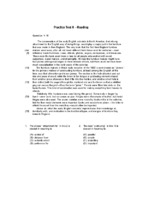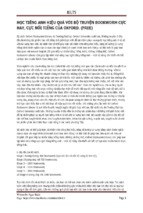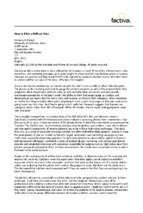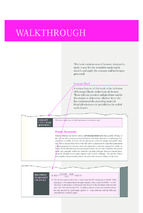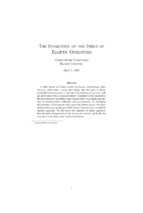Pesticides: A toxic time bomb in our midst
Pesticide exposure has long been a cause for concern, and with good reason. Studies have shown that all persons, but especially children, pregnant women, farmers, farmworkers, and the elderly, may experience negative health effects from pesticide exposure. These effects may include acute poisoning, cancer, neurological damage, birth defects, reduced sperm count, suppressed immune systems, and reproductive and developmental harm. This book is a comprehensive examination of pesticide use, pesticide harm, and alternatives to harmful pesticides.
Pesticides: A Toxic Time
Bomb in Our Midst
Marvin J. Levine
PRAEGER
Pesticides
A Toxic Time Bomb in Our Midst
Mar vin J. Levine
Library of Congress Cataloging-in-Publication Data
Levine, Marvin J., 1930–
Pesticides : a toxic time bomb in our midst / Marvin J. Levine.
p. cm.
Includes bibliographical references and index.
ISBN 978–0–275–99127–2 (alk. paper)
1. Pesticides—Health aspects. 2. Pesticides—Environmental aspects.
3. Pesticides—Toxicology. I. Title.
RA1270.P4L48 2007
363.738’4—dc22
2007000057
British Library Cataloguing in Publication Data is available.
Copyright ' 2007 by Marvin J. Levine
All rights reserved. No portion of this book may be
reproduced, by any process or technique, without the
express written consent of the publisher.
Library of Congress Catalog Card Number: 2007000057
ISBN-13: 978-0-275-99127-2
ISBN-10: 0-275-99127-X
First published in 2007
Praeger Publishers, 88 Post Road West, Westport, CT 06881
An imprint of Greenwood Publishing Group, Inc.
www.praeger.com
Printed in the United States of America
The paper used in this book complies with the
Permanent Paper Standard issued by the National
Information Standards Organization (Z39.48–1984).
10 9
8 7 6 5
4 3 2 1
Contents
Preface
vii
One
The Pesticide Problem
Two
Pesticides in Agriculture
25
Pesticides in Food
65
Three
1
Four
Pesticides in Schools
113
Five
Pesticides in Homes, Lawns, and Gardens
157
Pesticides in the Air, Water, and Soil
187
Seven
International Trade in Pesticides
219
Eight
Remedies and Reflections
235
Selected Bibliography
245
Index
249
Six
To Dina
Preface
The writing of this book came about through a serendipitous circumstance. I wrote a
book dealing with child labor in the United States, published three years earlier, containing a chapter that included a description of the hazards migrant farmworkers and
their children face, not the least of which was exposure to pesticides. While mentioning the dangers pesticides posed, I thought that a book on pesticides could be a
future undertaking. However, I put it on the back burner and turned my full attention to the project at hand.
Approximately one year ago, I was considering other potential book topics, when
my wife, Dina, suggested a book on pesticides. I recalled that pesticides had been
mentioned in the child-labor book and agreed that it could be an interesting and
manageable proposition. Soon, I began research on that topic.
Agriculture, covered in the second chapter, was singled out because a substantial
majority, 70 percent or more, of pesticides are applied in U.S. farming operations on
an annual basis. Billions of dollars are spent in the sale and use of these hazardous
chemicals. Their deleterious impact upon the health of farmers, farmworkers, and
their children will be examined, with special emphasis on threats to the well-being of
several million migrant farmworkers’ families.
Another important topic deals with the health problems attributed to pesticide residues in food, most of which is grown using a variety of pesticides. Acute and chronic
effects on children’s health will be investigated.
A largely overlooked area also merits consideration. Nearly 90 percent of all U.S.
households use pesticides, primarily for insect control. The number and concentration of pesticides detected in the indoor air of homes is typically greater than those
discovered in the air outdoors. People spend the majority of their time indoors, more
than 90 percent of each day. Millions of pounds of these toxic chemicals are also
applied on American lawns and gardens, when safer alternatives are available.
Furthermore, in too many of the 110,000 school districts across the nation,
untrained personnel are making critical decisions day in and day out about the use of
pesticides in school buildings and on school grounds. Children attend at least 180
days of school each year. An increased incidence of learning disorders has been linked
to this pesticide use. Federal law permits protections for farmers from re-entering
fields too soon after pesticide applications, but no such measures are available in the
case of many schools.
A serious health problem is also posed by some level of pesticide contamination of
drinking water in every state nationwide, in both agricultural and urban regions. Continuous monitoring will be essential to alleviate this health peril to our population.
In addition, other topics scrutinized here include testing, data collection, legislation, regulation, and political influence exerted by pesticide manufacturers.
I hope this book will heighten public awareness of the dangers pesticides pose for
humans, wildlife, and the environment.
The following persons and organizations deserve thanks for their assistance: Linda
Greer of the Natural Resources Defense Council in Washington, D.C.; Carol
Raffensperger and Ted Schettler of the Science and Environmental Health Network
in Ames, Iowa; The Center for Health, Environment & Justice in Falls Church,
Virginia; Aviva Glazer of the School Pesticide Monitor in Washington, D.C.; Beyond
Pesticides in Washington, D.C.; and Suzanne and Ralph Tarica.
A special debt is owed to my editors at Praeger Publishers, Hilary Claggett, and
James R. Dunton, for their timely assistance in the preparation of the manuscript.
Last, but not least, I take full responsibility for any errors of omission or
commission.
viii
|
Preface
One
The Pesticide Problem
If we don’t change direction soon, we’ll end up where we’re going.
—Professor Irwin Corey
Professor Irwin Corey was considered a guru of comedy by those who remember him
when he was a regular on the Steve Allen television shows of the 1950s and 1960s.
However, there is nothing humorous about the subject of this book—pesticides—and
his message has become increasingly relevant.
There is growing public concern regarding pesticide exposure, and for good reason.
Studies have shown that all people, especially children, pregnant women, farmers, farmworkers, and the elderly, may experience negative health effects from exposure to pesticides. Pesticide exposure can cause acute poisoning, cancer, neurological damage, birth
defects, and reproductive and developmental harm.1 Much evidence has revealed that
many commonly used pesticides can suppress the normal response of the human
immune system, making the body more vulnerable to invading viruses, bacteria, parasites, and tumors, increasing the incidence of disease and some cancers.2 Some evidence
indicates that pesticides may reduce male sperm counts.3 Unfortunately, pesticides are
widely used in our environment to control pests, but we the people rarely hear about it.
Fortunately, there are ways to reduce pesticide use and exposure.
Pesticides, by design, are toxic to certain life forms. Currently in the United States
there are more than 17,000 registered pesticide products and more than 800 active
ingredients. Acute pesticide-related illness and injury continues to be a problem.
According to poison control center data, there are approximately 18,000 unintentional pesticide exposures each year. Approximately 1,400 of these are occupational.4
According to Bureau of Labor Statistics data, annually there are 500 to 900 lost
work-time illnesses caused by pesticide exposure. Finally, there are approximately fifteen to twenty death certificates per year that contain codes for unintentional pesticide poisoning. All of these estimates are thought to be underestimates of the true
incidence of unintentional acute pesticide-related illness and injury.5
Historical Patterns of Pesticide Use
The era of pesticides began in the nineteenth century when sulfur compounds were
developed as fungicides. In the late nineteenth century, arsenic compounds were
introduced to control insects that attack fruit and vegetable crops; for example, lead
arsenate was used widely on apples and grapes. These substances were acutely toxic.
In the 1940s the chlorinated hydrocarbon pesticides, most notably DDT (dichlorodiphenyltrichloroethane), were introduced. DDT and similar chemicals were used
extensively in agriculture and in the control of malaria and other insect-borne diseases. Because they had little or no immediate toxicity, they were widely hailed and
initially believed to be safe.6
Widespread use of synthetic pesticides in the United States began after World War II.
The ingredients for many of today’s pesticides were, in fact, created as weapons of
war.7 Before the development of synthetic pesticides, farmers used naturally occurring
substances such as arsenic and pyrethrum.8 Pesticide use was credited with increasing
crop yields by reducing natural threats and became an integral part of agricultural
practices by the mid-1950s. Over the past five decades, American agriculture has dispersed thirty billion pounds of pesticides into the environment.9 Also, beginning in
the late 1940s, federal and local governments sponsored the widespread spraying of
DDT and other chemicals in urban communities in an effort to eradicate mosquitoes,
fire ants, gypsy moths, the Japanese beetle, and other insects judged to be harmful.
Every year in the United States, 1.1 billion pounds of active pesticide ingredients
are released into the environment; 834 million pounds (77 percent) are used in agriculture, the remainder for non-agricultural purposes. If the use of wood preservatives,
disinfectants, and sulfur is included, the yearly amount of pesticide usage increases to
2.2 billion pounds of active ingredients.10 Altogether, U.S. pesticide usage equals
more than four pounds per person annually.11
Insects, however, quickly develop resistance to pesticides. In addition, broadspectrum pesticides kill natural predators that keep pests in check. Use of synthetic
pesticides—including insecticides, rodenticides, fungicides, herbicides, and others—has
increased more than thirty-three-fold in the last half century. Ironically, it is estimated
that more of the U.S. food supply is lost to pests today (37 percent) than in the 1940s
(31 percent). Total crop losses from insect damage alone have nearly doubled from
7 percent to 13 percent during that period. Cultivation of four crops—soybeans, wheat,
cotton, and corn—consumes around 75 percent of the pesticides used in the United
States.12
Following World War II, pesticides were a component of what was predicted to be a
‘‘green revolution’’ of abundant food for the world. Over the past fifty years, agricultural
production in many areas of the world has increased dramatically, partly because of the
use of herbicides and insecticides. Health benefits, such as those related to the eradication of malaria-carrying mosquitoes, were also foreseen and, in many cases, attained.
In May 1962, biologist Rachel Carson alerted the public to the side effects of pesticides in her book, Silent Spring. Questions were raised about the actual (rather than
2
|
Pesticides
the perceived) benefits of pesticides, along with questions about environmental and
public health risks.13
The pathways of human exposure to pesticides are numerous. Pesticide residues
are found virtually everywhere: in the office and home, on food, in drinking
water, and in the air.14 Throughout more than a half century of pesticide use,
most pesticides have never been systematically reviewed to evaluate their full range
of long-term health effects on humans, such as potential damage to the nervous,
endocrine, or immune systems. The Environmental Protection Agency (EPA) considers only cancers in determining the potential threat of pesticides to human
health. Until recently, cancer has been considered the most sensitive end point—if
you could prevent cancer, you could prevent other chronic diseases. Furthermore,
scientists have been able to develop the model by which they can extrapolate cancer data from animal studies. The concept that cancer is the most sensitive end
point is now being seriously questioned. The effects of pesticides on wildlife are
also not well documented. It wasn’t until 1985 that the EPA reviewed an insecticide solely on the basis of its effects on wildlife.15 Since then, the EPA has
banned some pesticides based partially on their effects on the environment and
wildlife. Discoveries of pesticide residues have also resulted in fishing bans in bays,
lakes, and rivers.16
Agricultural pesticides have prevented pest damage of between 5 percent and 30
percent of potential production in many crops.17 Pesticides, however, have posed a
number of problems for agriculture, including the killing of beneficial insects, secondary pest outbreaks, and the development of pesticide-resistant pests.18 Several
studies have shown a decrease in the effectiveness of pesticides. According to one
study, 7 percent of U.S. agricultural production was lost to pests in the 1950s; in
1993, 13 percent of all production was lost to pests.19 A different study concluded
that crop losses from pests increased from 30 percent in 1945 to 37 percent in 1990.
During that same period farmers used thirty-three times more pesticides.20
Today, 440 species of insects and mites and more than seventy fungi are now resistant to some pesticides.21 Consequently, it has become necessary to use larger doses
and more frequent applications of pesticides. Combining pesticides, or substituting
more expensive, toxic, or ecologically hazardous pesticides, occurs more frequently. In
addition to the problem of pesticide resistance, millions of dollars worth of crops
have been lost as a result of improper pesticide application.22
Health Effects on Children
Pesticides have been associated with the development of certain cancers in children,
including leukemia, sarcomas, and brain tumors. Many classes of pesticides have been
shown to adversely affect the developing nervous system of animals used in experiments. Parental exposure to pesticides has been linked with birth defects in children.
New studies suggest that pesticides may compromise the immune systems of infants
and children. Children are exposed to pesticides at home, at school, in playgrounds
The Pesticide Problem
|
3
and parks, in food, and in water. Nationwide, 85 percent of households had at least
one pesticide, and 47 percent of households with children under the age of five were
found to store at least one pesticide within the reach of children. Parents can eliminate the use of pesticides in and around their homes and workplaces and pressure
school boards to reduce pesticide use in schools. If possible, parents can buy organically grown and in-season foods. Congress passed legislation in 1996 designed to
improve regulation of pesticides, particularly in food, so that children are adequately
protected. The implementation of this law will be a critical test of the EPA’s intention
to safeguard the next generation. Additional reforms needed include reducing the use
of pesticides, better testing of pesticides’ ability to affect infants and young children,
and more data on children’s exposure to pesticides.23
Controversy has arisen regarding the apparent increase in the incidence of childhood cancer in the United States. Some investigators, particularly at the EPA, have
raised concerns that this increase may reflect new or increasing environmental exposures. The alternative view is that there has been little overt change in incidence, and
that apparent increases in, for example, brain tumors, reflect changes in medical practice and diagnostic methods rather than a true increase in occurrence. Part of the difficulty in understanding childhood cancer trends lies in the relative rarity of most
cancer types and the lack of a national system of cancer registration that would enable
researchers to track incidence on a nationwide scale.24
Children may be more susceptible than adults to environmental health risks
because of their physiology and behavior. They eat and drink more and breathe more
air in proportion to their body weight than adults. They also play close to the ground
and put objects in their mouths. Their bodies are still developing, and they may be
less able than adults to metabolize and excrete pollutants.
In 1996, poison control centers nationwide were notified about approximately
80,000 children (aged from birth through nineteen) who were exposed to common
household pesticides, an estimated one-quarter of whom developed symptoms of pesticide poisoning. From 1992 to 1998, an estimated 24,000 emergency room visits
resulted annually from pesticide exposure; 61 percent of the cases involved children
younger than age five.25
New Discoveries About Pesticides
Although pesticides do offer certain benefits for farmers and others, new scientific
research is revealing some important health-related issues associated with their usage.
Recently, for example, some scientists have become convinced that there is a relationship between pesticides that mimic the estrogen hormone and the disruption of the
endocrine systems in humans and wildlife. This potentially could contribute to serious health problems, including breast and other types of cancer in humans, and
reproductive disorders.26 Currently, in registering pesticides, the EPA does not require
tests for estrogen involvement; if a pesticide is found to be estrogenic, the EPA has
no method of removing it from the market.27
4
|
Pesticides
Though there is no conclusive evidence to date, several studies have indicated that
chemicals that imitate estrogen might cause reproductive problems in animals. For
example, one study found that male alligators exposed to pesticides in Florida are
having difficulty reproducing, partly because their penises are not developing to normal size. This reproductive interference could be related to exposure to estrogenic
pesticides. It also has been reported that some birds, fish, amphibians, and mammals
are being ‘‘feminized’’ by exposure to low levels of pesticides and other industrial
chemicals.28
Pesticide Usage
Pesticides of various types are used in most sectors of the U.S. economy. In general
terms, a pesticide is any agent used to kill or control undesired insects, weeds,
rodents, fungi, bacteria, or other organisms. Thus, the term ‘‘pesticides’’ includes
insecticides, herbicides, rodenticides, fungicides, nematicides, and acaricides as well as
disinfectants, fumigants, wood preservatives, and plant growth regulators. Pesticides
play a vital role in controlling agricultural, industrial, home/garden, and public health
pests. Many crops, commodities, and services in the United States could not be supplied in an economic fashion without controlling pests using chemicals or other
means. As a result, goods and services can be supplied at lower costs and/or with better quality. As has been pointed out, these economic benefits from pesticide use are
not achieved without potential risks to human health and the environment due to
the toxicity of pesticide chemicals. For this reason, these chemicals are regulated
under federal or state pesticide laws to avoid unacceptable risks.
The EPA registers pesticides for use and requires manufacturers to label pesticides
about when and how to use them. It is important to remember that the ‘‘cide’’ in pesticide means ‘‘to kill.’’ These products can be dangerous if not used properly.
Annual pesticide use in the United States equals about 8.8 pounds per capita, relatively stable at roughly 2.2 billion pounds of active ingredients, according to an EPA
pesticide industry sales and usage report. According to the report, use of what are
considered ‘‘conventional pesticides’’ remains at about 1.1 billion pounds of active
ingredients, but the addition of wood preservatives and disinfectants pushes total pesticide use to about 2.2 billion pounds of active ingredients. Pesticides are used on
more than 900,000 U.S. farms and in 69 million households, the report indicated,
while the herbicides atrazine and metolachlor are the two most widely used pesticides
in the country, at 70 million to 75 million pounds and 60 million to 65 million
pounds, respectively.29
Three Major Groups of Conventional Pesticides
The first group consists of chlorinated hydrocarbons, also known as organochlorines. These pesticides generally break down very slowly and can remain in the environment for long periods of time. Dieldrin, chlordane, aldrin, DDT, and heptachlor
are pesticides of this type. The second group is known as organic phosphates or
The Pesticide Problem
|
5
organophosphates. These pesticides are often highly toxic to humans, but generally
do not remain in the environment for long. Diazinon, malathion, dimethoate, and
chlorpyrifos are pesticides of this classification. The last group is the carbamates.
They are generally less toxic to humans, but concerns persist about the potential
effects of some carbamates on immune and central nervous systems. Carbaryl, carbofuran, and methomyl are examples of carbamates.30
Pesticide Safety Myths
There is no such thing as a ‘‘safe’’ pesticide. In fact, pesticide labels describe their
products as possessing varying degrees of toxicity. For that matter, it is illegal for pesticide manufacturers to allege safety as a pesticide characteristic in their promotional
efforts. Different pesticides affect people in different ways. Some cause cancer and are
listed as ‘‘known’’ or ‘‘possible’’ carcinogens as identified by the EPA or state environmental agencies. Some are nerve toxins, which affect the enzyme responsible for the
basic operation of the brain and nervous system. Many originate from World War II
research on chemical weapons. These include organophosphate and carbamate insecticides such as chlorpyrifos and diazinon. Acute (immediate) poisoning symptoms
are flu-like, featuring nausea, vomiting, diarrhea, or dizziness. These pesticides may
also impair memory, learning ability, ability to focus, and even normal behavior.
Reproductive and developmental toxins are those that impact the development of
children.31 Exposure to these chemicals may jeopardize a child’s mental or physical
development. Pregnant women exposed to these chemicals may face increased risk of
birth defects in their unborn children. Hormone-mimicking toxins also known as endocrine disruptors can disrupt delicate hormonal processes in wildlife and humans.
Hormones act as chemicals in the human body, triggering a wide array of biological
processes. They can impact height and weight, gender differentiation, the development
of reproductive organs, and energy levels. Because hormones function at very low levels,
these pesticides can have dramatic effects even at modest levels of exposure.32
Pesticide Resistance
In addition to directly poisoning our environment and our food, pesticides pose a
serious threat to our food production system itself. From one viewpoint, pesticides
are wonder chemicals that have increased food production by 20 percent since 1940
by reducing pest damage. Yet over the same period, they have also created at least
261 strains of insect species, sixty-seven strains of plant pathogens, two strains of
nematodes (parasitic worms), and four (or by some counts, nineteen) strains of weeds
that they cannot kill. While insecticide use has increased tenfold since the 1940s,
crop losses to insects doubled.33
The key to this paradox is the selection for resistance that pesticides exert on their
target pests. Pesticides never kill 100 percent of a pest population, and the survivors
tend to have a lower susceptibility to that particular chemical. With every repeated
application of the same pesticide, these naturally resistant individuals make up a
6
|
Pesticides
higher percentage of the population, until a highly resistant strain of pest evolves.
When the conditions are right, the pesticide kills a large percentage of the pest population, the pest completes several life cycles per year, and little movement from
untreated populations occurs. Then resistance can develop very rapidly.
Resistance to one pesticide often confers resistance, or faster development of resistance, to a whole family of related pesticides. Alternating different pesticides or applying a mixture of chemicals can sometimes delay the development of resistance, but it
can also promote the development of super-resistant pests, called superpests, which
are resistant to multiple pesticides. Superpests have already developed and threaten a
number of crops throughout the world.34
Fate of Pesticides in the Environment
Ideally, a pesticide stays in the treated area long enough to produce the desired
effect and then breaks down into harmless materials. Three primary modes of degradation occur in soils:
¥ biological—breakdown by micro-organisms
¥ chemical—breakdown by chemical reactions, such as hydrolysis (soluble decomposition) and oxidation
¥ photochemical—breakdown by ultraviolet or visible light
The rate at which a chemical degrades is expressed as the half-life, which is the
amount of time it takes for half of the pesticide to be converted into something else, or
until its concentration is half of its initial level. The half-life of a pesticide depends on
the soil type, its formulation, and environmental conditions such as temperature and
moisture levels. Other processes that influence the fate of the chemical include plant
absorption, soil adhesion, leaching, and vaporization. If pesticides migrate from their
targets due to wind drift, runoff, or leaching, they are considered to be pollutants. The
potential for pesticides to move depends on the chemical properties and formulation of
the pesticide, soil properties, the rate and method of application, pesticide persistence,
frequency and timing of rainfall, irrigation, and depth to ground water.35
Pesticide Toxicity
Toxicity is the inherent ability of a pesticide to cause injury or death, indicating how
poisonous the chemical is. Acute toxicity is the ability of a substance to cause harm as
the result of a single dose or exposure to a chemical. Chronic toxicity is the ability of a
substance to cause injury as the result of repeated doses or exposures over time. Any
chemical substance is toxic if it is ingested or absorbed in excessive amounts. Table salt,
for example, if consumed in excess, can be toxic. The degree of danger or hazard when
using a pesticide is determined by multiplying toxicity times exposure.
The Pesticide Problem
|
7
The designation given to a pesticide indicating its relative level of toxicity is called
the lethal dose, or LD50 value. This value identifies the dosage necessary to kill
50 percent of a test population. The lethal dose is expressed in milligrams of chemical per kilogram of body weight of the test population. The lower the LD number,
the more toxic the material. The toxicity rating is important as an indicator, but the
length of exposure, type of exposure, and other factors also impact the relative hazard
of any pesticide. The toxicity of pesticides is often measured using an LD50 (lethal
dose) or an LC50 (lethal concentration). Both the LD50 and LC50 measure only acute
effects and therefore provide no information about a chemical’s connection to longterm health issues.36
The tests for acute and chronic toxicity are the only science-based methods currently used to predict risks to users and consumers. But they have limitations. These
tests are usually done on rodents, which may not always accurately predict effects on
humans. Plus, they do not take into consideration possible interactions and consequences of several compounds acting together.
All labels include the warning, ‘‘Keep out of reach of children.’’ In addition, most
labels include ‘‘signal words’’ which give an indication of the pesticide’s toxicity or
corrosiveness. These signal words are relative terms. They indicate how pesticides
compare to one another. Even if a pesticide is considered to be relatively low in toxicity, it can be a deadly poison at a fairly low dose.37
Inert Ingredients
Pesticide products contain both ‘‘active’’ and ‘‘inert’’ ingredients. These terms have
been defined by a federal law, the Federal Insecticide, Fungicide, and Rodenticide Act
(FIFRA) of 1947. An active ingredient is one that prevents, destroys, repels, or mitigates a pest, or is a plant regulator, defoliant, desiccant, or nitrogen stabilizer. By law,
the active ingredient must be identified by name on the label together with its percentage by weight. An inert ingredient is simply an ingredient in the product that is
not intended to affect a target pest. For example, isopropyl alcohol may be an active
ingredient and antimicrobial pesticide in some products; however, in other products,
it functions as a solvent and may be considered inert. The law does not require inert
ingredients to be identified by name and percentage on labels, but the total percentage of such ingredients must be declared.38
Inert Name Change
In September 1997, the EPA issued a regulation notice to encourage manufacturers, formulators, producers, and registrants of pesticide products to voluntarily
substitute the term ‘‘other ingredients’’ as a heading for the ‘‘inert’’ ingredients in the
ingredient statement on pesticide labels. The EPA made this change after learning the
results of a consumer survey on the use of household pesticides. Many comments
from the public and the consumer interviews prompted the EPA to discontinue the
use of the term ‘‘inert.’’ Many consumers are misled by the term ‘‘inert ingredient,’’
8
|
Pesticides
believing it to mean ‘‘harmless.’’ Since neither federal law nor the regulations define
the term ‘‘inert’’ on the basis of toxicity, hazard, or risk to humans, non-target
species, or the environment, it should not be assumed that all inert ingredients are
non-toxic.39
Status of Inert Ingredients
Inert ingredients have definitely not been given a clean bill of health. For example,
it is not clear which components of weed killers are carcinogens. The question
revolves around whether it is the active ingredients, the dioxins, that contaminate the
active ingredients during manufacture, or the inert ingredients, which frequently constitute 90 to 99 percent of pesticides. Inert ingredients are added as fillers or to give
the pesticide a desirable quality. The EPA lists 2,000 chemicals that have been
approved for use as inert ingredients. These include urea formaldehyde, carbon tetrachloride (known to cause cancer), chloroform (also a known carcinogen), toluene, xylene, cadmium, and lead compounds. Pesticide manufacturers have successfully
claimed that the components of inert ingredients are trade secrets not required to be
disclosed to potential competitors. Furthermore, federal law imposes a $10,000 penalty on any employee who reveals the contents of inert ingredients in pesticides.40
Agricultural Pesticides
Much of modern farming relies on pesticides to produce food of a high quality
and ensure consistent supplies. In some cases pesticides can make the difference
between success and failure of a crop. Pesticides are a vital part of modern agriculture,
protecting food and fiber from damage by insects, weeds, diseases, and rodents. U.S.
agriculture companies spend about eight billion dollars annually on pesticides, which
accounts for more than 70 percent of all pesticides sold in the country.41 It is estimated that each dollar invested in pesticide control returns approximately four dollars
in crops saved from pests. Farmers’ expenditures on pesticides are about 4 to 5 percent of total farm production costs.42
The dependence of agriculture on chemical pesticides developed over the last sixty
years as the agricultural sector shifted from labor-intensive production methods to
more capital- and chemical-intensive production methods. Sixty years ago, most crops
were produced largely without the use of chemicals. Insects and weeds were controlled by crop rotations, destruction of crop refuse, timing of planting dates to avoid
high pest population periods, mechanical weed control, and other farming practices.
While these practices are still in use, changes in technology, costs, and government
policies have led to the development of today’s chemically intensive farming methods.
Usage of conventional pesticides on farms in the United States increased from
about 400 million pounds (of active ingredients) in the 1960s to more than 800 million pounds in the late 1970s and early 1980s, primarily due to the widespread adoption of herbicides in corn production. Since that time, usage has been somewhat
lower, ranging from about 700 to 800 million pounds annually.43 Pesticide usage in
The Pesticide Problem
|
9
agriculture can vary considerably from year to year, depending on weather, pest outbreaks, crop acreage, and economic factors such as pesticide costs and crop prices.
Whereas the quantity of pesticides used by farmers has fallen off slightly in recent
years, total expenditures on pesticides are still increasing.
During the 1960s, agricultural pesticide use was dominated by insecticides,
accounting for about half of all pesticides used. The quantity of insecticides applied
fell as the organochlorines (DDT, aldrin, and toxaphene) were replaced by pyrethroids and other chemicals that require lower application rates. Today, 70 percent of
pesticides used are herbicides, with corn leading all other crops by a substantial margin in total pesticide use. Rice, potatoes, vegetables, and fruits, however, actually use
pesticides more intensively than corn and other crops. Minimum tillage practices are
being adopted by many farmers, reducing the need for machinery, labor, and energy
inputs, but increasing farming’s dependency on pesticides even more. Pesticide use
trends can vary markedly from one part of the country to another as farmers respond
to local pest problems and as crop production patterns vary.
Concerns about potential risks to health and the environment resulted in amendments to FIFRA in 1972, increasing the stringency of health and safety data required
to support a pesticide registration. The EPA first banned the usage of some organochlorine pesticides for agricultural purposes in the 1970s, and has since imposed use
limitations on many other pesticides. The amendments also required that all existing
pesticides be reregistered using current health and environmental standards. Chemical
companies have responded to these regulatory pressures by marketing new chemicals
that are thought to be less harmful to humans and the environment, or less likely to
migrate from farm fields to contaminate groundwater and surface water.
Schools and Pesticides
Safeguarding children’s health while at school is a priority for parents, teachers, school
administrators, lawmakers, and clinicians. Yet children are continually and unknowingly
exposed to toxic chemicals while in and around school buildings. Substantial scientific
evidence indicates that children are at risk for diseases as a result of these exposures.
Despite the hazards to children and the environment, pesticides have become a
preferred approach to controlling pest problems in many schools and school districts.
Toxic chemicals are being used on school athletic fields, shrub beds, parking lots,
tracks, play areas, and in cafeterias, classrooms, gymnasiums, and restrooms. Too often pesticides are applied by unlicensed personnel, or applied on a calendar basis
whether pests are present or not.
In general, research demonstrates that pesticide poisoning can lead to poor performance on tests involving intellectual functioning, academic skills, abstract reasoning, flexibility of thought, and motor skills. Other areas affected include memory
disturbances and inability to focus attention, reduced perceptual speed, and deficits
in intelligence, reaction time, and manual dexterity. Increased anxiety and emotional
problems have also been reported.
10
|
Pesticides
Pesticide opponents estimate there are some fifty insecticides, herbicides, and fungicides commonly used in and around schools. Some are implicated in reproductive and
neurological problems, kidney and liver damage, and cancer. Additionally, the following have been reported as adverse health effects of forty-eight commonly used pesticides
in schools: twenty-two are probable or possible carcinogens, twenty-six have been
shown to have reproductive effects, thirty-one damage the nervous system, thirty-one
injure the liver or kidneys, forty-one are sensitizers or irritants, and sixteen can cause
birth defects. Because most of the symptoms of pesticide exposure, from respiratory
distress to difficulty in concentration, are common in schoolchildren and may also have
other causes, pesticide-related illnesses often go unrecognized and unreported.44
The GAO Study
In the fall of 1999, the General Accounting Office (GAO), at the request of Democratic Senator Joseph Lieberman of Connecticut, conducted a national review of the
extent to which pesticides are used in and around the nation’s 110,000 public schools
and the magnitude of the risk of exposure to children. The report found that the data
on the amount of pesticides used in the nation’s public schools is neither available
nor collected by the federal and most state governments. The study also revealed that
the EPA is not doing enough to protect children from pesticides, and that there is
limited information on how many children are exposed to pesticides in schools. The
GAO cited the EPA’s analysis of the American Association of Poison Control Centers’
Toxic Exposure Surveillance System, documenting 2,300 school pesticide exposures
from 1993 to 1996. Because most of the symptoms of pesticide exposure, from respiratory distress to difficulty in concentration, are common and may be assumed to
have other causes, it is suspected that pesticide-related illnesses are much more prevalent than presently indicated.
Specifically, the GAO found that:
1. There are no comprehensive, readily available national or state-by-state data on
the amount and kinds of pesticides being used in schools today.
2. Although FIFRA requires pest control companies to keep records for two years
on the amount and site of pesticide applications, only one state requires them
to report this information to the relevant agency.
3. There is little information available about illnesses related to pesticide exposure. The GAO documented 2,300 cases of exposure at schools from 1993 to
1996, but noted that this information is incomplete and unreliable because of
the lack of record-keeping, and therefore likely underestimates how often children are exposed. In addition, of those 2,300 cases, the outcomes in 1,000 of
them are not known, or more than 40 percent are incomplete. For the cases
where follow-up did occur, 329 individuals were seen at health care facilities,
fifteen were hospitalized, and four were treated at intensive care units.
The Pesticide Problem
|
11
4. Eight states collect information on the use of pesticides within their states, but
only two collect information on pesticides used in schools. No state collects information on exposure patterns in schools.
5. There are no standard criteria for clearly identifying illnesses linked to pesticide
exposure; misclassification of pesticide illness is common.45
Eliminating pesticides from the school environment is critical to lowering children’s total exposure. Children spend an average of six to seven hours per day, five
days per week, 180 days per year, in school. The only other place where children
spend more time is in their homes. In order to protect children’s health wherever they
work and play, pesticide use in schools must be reduced, and families must be routinely notified whenever pesticides will be applied in schools.
As the public becomes more aware of the health and environmental risks pesticides
may pose, interest in seeking the use of equally effective alternative pest control methods increases. School administrators and others who have pest control decision-making
responsibilities for school buildings and grounds should become aware of the pest control options available to them. It is in everyone’s best interest to reduce exposure to
potentially harmful chemicals in the educational environment.
Pesticides and Water Quality
Pesticides not absorbed by plants and soils or broken down by sunlight, soil organisms, or chemical reactions may ultimately reach groundwater sources of drinking
water. This depends on the nature of the soil, depth to groundwater, chemical properties of the pesticide, and the amount and timing of precipitation or irrigation in an
area. Usually, the faster a pesticide moves through the ground, as with sandy soils
and heavy rainfall or irrigation, the less filtration or breakdown. Heavier soils, combined with lower moisture levels and warmer temperatures, provide a greater opportunity for pesticides to break down before reaching groundwater. The amount of a
pesticide detected in well samples also relates to the kind of pesticide and the amount
originally applied. Contamination problems can result from using high concentrations of water-soluble pesticides for a specific crop in a vulnerable area.
Pesticides are, of course, designed to be toxic for certain insects, animals, plants, or
fungi. But when used without regard to site characteristics, such as adsorption
capacity of the soil (‘‘adhesion’’), solubility, climatic conditions, and irrigation patterns, a given pesticide can create greater environmental problems than the damage
the target pest could cause. Once in groundwater, pesticides continue to break down,
but usually much slower than in surface layers of soil. Groundwater carrying pesticides away from the original point of application can lead to contaminated well samples years later in a different location.
To avoid pesticide contamination, informed and careful pest control is necessary.
Overapplication is a possible cause of pesticides in water supplies. Consequently,
pesticides should not be viewed as the only answer to a pest problem; other methods
12
|
Pesticides
may be appropriate. Integrated Pest Management (IPM) may include crop rotation,
biological control, and soil analysis and conditioning.46
Health Effects
When pesticides are found in water supplies, they normally are not present in high
enough concentrations to cause acute health effects such as chemical burns, nausea, or
convulsion. Instead, they typically occur in trace levels, and the concern is primarily
for their potential to cause chronic health problems. To estimate chronic toxicity, laboratory animals are exposed to lower-than-lethal concentrations for extended periods of
time. Measurements are made of the incidence of cancer, birth defects, genetic mutations, or other problems such as damage to the liver or the central nervous system.
Although we may encounter many toxic substances in our daily lives, in low
enough concentrations they do not impair our health. Caffeine, for example, is regularly consumed in coffee, tea, chocolate, and soft drinks. Although the amount of caffeine consumed in a normal diet does not cause illness, just fifty times this amount is
sufficient to kill a human. Similarly, the oxalic acid found in rhubarb and spinach is
harmless at low concentrations found in these foods, but will lead to kidney damage
or death at higher doses.
Laboratory measurements of a pesticide’s toxicity must be interpreted in the context
of its potential hazard under actual field conditions. Pesticides by definition are toxic
to at least some forms of life, but whether or not a particular pesticide in groundwater
is hazardous to human health depends on its concentration, how much is absorbed
from water or other sources, the duration of exposure to the chemical, and how quickly
the compound is metabolized and excreted from the body. Drinking-water guidelines
are aimed at keeping pesticides at levels below those that are considered to cause any
health effects in humans. They are derived from laboratory data using one of two
methods, depending on whether or not the compound causes cancer.47
Pesticide contamination of groundwater is a national issue because of the widespread use of pesticides, the expense and difficulty of cleansing groundwater, and the
fact that groundwater is used for drinking water by about 50 percent of Americans.
Concern about pesticides in groundwater is especially acute in rural agricultural areas,
where more than 95 percent of the population relies on groundwater for their drinking water, although application rates and the variety of pesticides used may be greater
in urban areas. Weed killers, bug killers, and other pesticides still contaminate thousands of water supplies nationwide. For hundreds of Midwestern communities, pesticide runoff to rivers and streams results in tap water commonly contaminated with
five or more weed killers during peak runoff each spring and summer. Communities
that use reservoirs are exposed to these mixtures year-round. Everyone who drinks the
water is affected, including millions of babies who consume pesticides when parents
feed them infant formula reconstituted with tap water. The EPA’s review of the
pesticide that most commonly contaminates tap water—the carcinogenic weed killer
atrazine—has stalled, despite the fact that it contaminates some 1,500 water systems
The Pesticide Problem
|
13
- Xem thêm -



